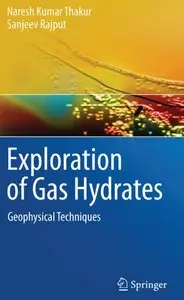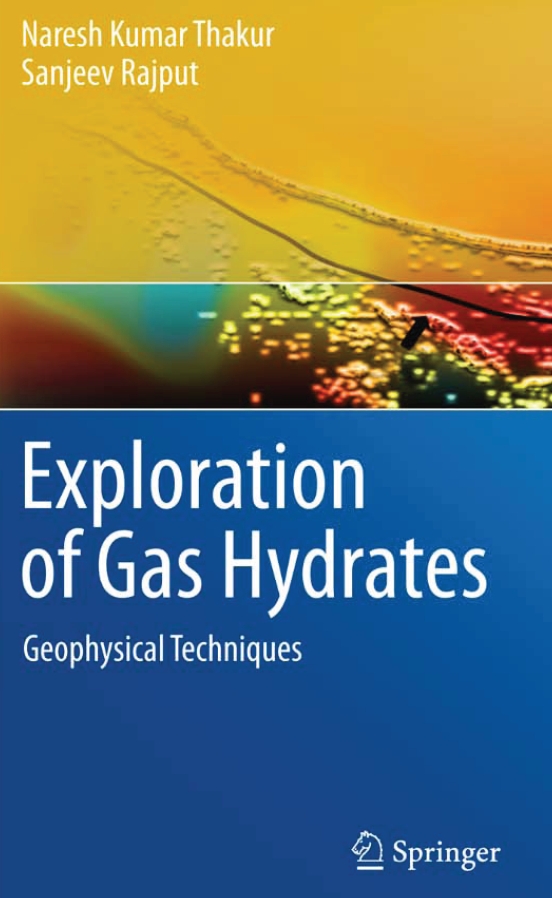"Exploration of Gas Hydrates: Geophysical Techniques" by Naresh Kumar Thakur, Sanjeev Rajput
Sрringеr | 2010 | ISBN: 3642142338 9783642142338 9783642142345 | 293 pages | PDF | 19 MB
Sрringеr | 2010 | ISBN: 3642142338 9783642142338 9783642142345 | 293 pages | PDF | 19 MB
This book treats various geophysical techniques in order to quantify the gas hydrate reserves and their impact on environment. The primary goal of this book is to provide the state of art for gas hydrate exploration. The target audiences for this book are non-specialist from different branches of science, graduate students and researchers.
Gas hydrates are ice-like crystalline substances that form a rigid cage of water molecules and entrap hydrocarbon and non-hydrocarbon gas by hydrogen bonding.
Natural gas hydrate is primarily composed of water and methane. These are solid, crystalline, ice-like substances found in permafrost areas and deepwater basins around the world. They naturally occur in the pore space of marine sediments, where appropriate high pressure and low temperature conditions exist in an adequate supply of gas (mainly methane).
Gas hydrates are considered as a potential non conventional energy resource. Methane hydrates are also recognized as, an influence on offshore platform stability, a major factor in climate change contributing to global warming and a significant contribution to the ocean carbon cycle.
Contents
1 Introduction
1.1 Introduction
1.2 Oil and Natural Gas
1.3 Coal Energy
1.3.1 Coal Gasification
1.3.2 Coal Liquefaction
1.3.3 Coal Bed Methane
1.4 Geothermal Energy
1.5 Nuclear Energy
1.6 Nuclear Fusion
1.7 Renewable Energy
1.7.1 Hydropower
1.7.2 Solar Energy
1.7.3 Bio-Energy
1.7.4 Wind Energy
1.7.5 Tidal Energy
1.7.6 Waves Energy
References
2 World’s Oil and Natural Gas Scenario
2.1 Introduction
2.2 Oil Scenarios
2.3 Natural Gas
2.3.1 Natural Gas Scenario
2.4 Unconventional Oil
2.4.1 Shale Oil
2.5 Unconventional Gas
2.5.1 Tight Sands
2.5.2 Shale Gas
2.5.3 Geopressured Zones
2.6 Hydrogen
References
3 Gas Hydrates
3.1 Introduction
3.2 What Are Gas Hydrates?
3.3 Crystal Structure
3.4 Where Gas Hydrates Are Found?
3.5 Gas Hydrates Indicators
3.5.1 Geophysical Signatures
3.5.2 Geological Proxies
3.5.3 Geochemical Evidences
3.5.4 In-Situ Measurements
3.6 Possible Resource Estimates
References
4 Stability Conditions
4.1 Introduction
4.2 Availability of Methane
4.3 Pressure–Temperature Conditions
4.3.1 Hydrostatic Pressure
4.3.2 Hydrothermal Gradients
4.3.3 Geothermal Gradients
4.4 Gas Hydrate Stability Zone
4.4.1 Salinity
4.4.2 Gas Composition
4.4.3 Solubility of Methane
4.4.4 Geological Controls
4.5 Planetary Hydrates
4.6 Climatic Impact
4.7 Geological Hazards
References
5 Geological Indicators
5.1 Introduction
5.2 Geological Indicators
5.2.1 Distribution and Variability of BSR
5.2.2 Sediment Deposition and Distribution
5.2.3 Diapirism
5.2.4 Fluid Migration Features
References
6 Geophysical Indicators
6.1 Introduction
6.2 Geophysical Indicators
6.2.1 The Bottom Simulating Reflectors
6.2.2 Enhanced Seismic Reflections Below BSR
6.2.3 Seismic Chimney and Amplitude Blanking
6.2.4 Hydrate Mounds
6.2.5 Instantaneous Seismic Attributes
References
7 Geophysical Surveys and Data Analysis
7.1 Introduction
7.2 2D/3D Conventional Seismic Surveys
7.3 4C Ocean Bottom Seismic Surveys
7.3.1 Patterns in Travel Time for Ocean Bottom Seismometer Experiments
7.3.2 Example of 4C Seismic Experiment
7.4 Vertical Seismic Profile Surveys
7.4.1 The Beginning Point: Zero Offset VSP
7.4.2 Walk-Away VSP
7.4.3 Cross-Well Seismic Surveys (CSP)
7.4.4 Some Remarks
7.5 Marine Controlled-Source Electromagnetic Methods (CSEM)
7.6 Seismic Data Analysis for Gas Hydrate Characterization
7.6.1 Patterns in Synthetic Seismograms for Gas Hydrates
7.6.2 Converted Wave Velocity Model for Gas Hydrate Studies
7.6.3 Processing of 4C OBS Data for Gas Hydrate Studies
7.7 Log Responses for Gas Hydrates
7.7.1 Electrical Resistivity Log Response
7.7.2 Spontaneous Potential Log Response
7.7.3 Caliper Log Response
7.7.4 Sonic Log Response
7.7.5 Neutron Log Response
7.7.6 Density Log Response
7.7.7 Some Remarks
References
8 Identification to Quantification of Gas Hydrates
8.1 Introduction
8.2 Regional Mapping of Gas Hydrates
8.2.1 An Example from Kerala-Konkan (KK) Basin Offshore India
8.2.2 Some Remarks
8.3 Amplitude Strength
8.3.1 Some Remarks
8.4 Amplitude vs. Offset Characteristics
8.4.1 Calculation of Synthetic Seismogram and Reflection Coefficient
8.4.2 Some Remarks
8.5 Seismic Attributes
8.5.1 Reflection Strength
8.5.2 Reflection Strength for Constant Thickness of Hydrate Layer with Different Thickness of Free Gas Layers
8.5.3 Reflection Strength for Constant Thickness of Free Gas Layer with Different Thickness of Gas Hydrate Layers
8.5.4 Example from Andaman Offshore Region, India
8.5.5 Example from Offshore Australia
8.5.6 Instantaneous Frequency
8.5.7 Instantaneous Frequency for Constant Thickness of Hydrate Layer with Different Thickness of Free Gas Layers
8.5.8 Instantaneous Frequency for Constant Thickness of Free Gas Layer with Different Thickness of Gas Hydrate Layers
8.5.9 Example from Andaman Offshore Region, India
8.5.10 Example from Offshore Australia
8.5.11 Some Remarks
8.6 Quantification Methods
8.6.1 Detection and Estimation of Gas Hydrates by Rock Physics and Inversion
8.6.2 Estimating Volumetric Concentration of Gas Hydrates by Modified Wood Equation
8.6.3 Example from KG Basin India (NGHP Expedition-01)
8.6.4 Integrating Geochemical and Geophysical Methods for Gas Hydrates Characterization
8.6.5 Waveform Inversion for Gas Hydrates
References
9 The Road Ahead
9.1 Introduction
9.2 Stability
9.3 Bottom Simulating Reflector
9.4 Blanking
9.5 Inferences from Velocities
9.6 AVO Modeling
9.7 Seismic Data Acquisition
References
Index
with TOC BookMarkLinks



